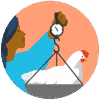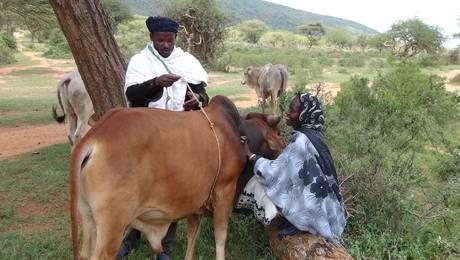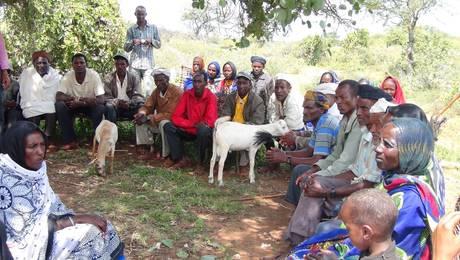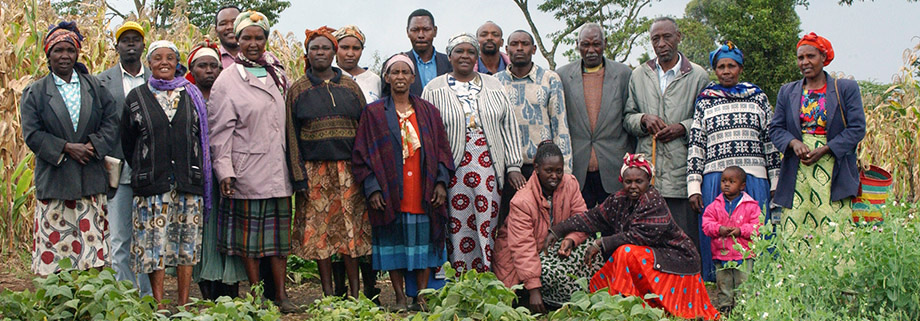
Livestock and Farmer Field Schools
In many countries across the world, livestock are an integral part of poor people’s livelihoods, contributing to household income, food security and nutrition. They can provide quality food (meat, milk, and eggs); capital (sale, barter and hire); fertilizer (manure); draught power for cultivation and transport; building materials (fibres and hides); and fuel (manure). In some societies, livestock also have important sociocultural and religious functions.
Over the past two decades, FAO started integrating livestock-focused Farmer Field Schools (FFSs) in several of its projects and programmes. Livestock FFS have been implemented/supported by FAO and many other development stakeholders, including the International Fund for Agricultural Development (IFAD), the International Livestock Research Institute (ILRI), the World Bank and numerous NGOs (VSF, Heifer International, etc.). Their improved FFS capacity benefitted thousands of livestock-dependent communities globally.
Initially focusing on crops, the FFS approach has been adapted to strengthen the critical analysis, decision-making and communication skills of small-scale livestock producers, both women and men, in many different contexts and environments, allowing them to create more efficient and sustainable systems, while building on local knowledge.
Over the years, the approach has been applied to many different livestock production systems, including pastoralism and agro-pastoralism, dairying, poultry production, integrated rice-duck systems, rabbit production, pig production, beekeeping, beef production, camel production and small ruminant production. Today, interest in using the approach for livestock development is growing among governments, NGOs, the private sector and other stakeholders.

- Agro-ecosystem analysis (©FAO/Solomon Nega)
Over the years, the approach has been applied to many different livestock production systems, including pastoralism and agro-pastoralism, dairying, poultry production, integrated rice-duck systems, rabbit production, pig production, beekeeping, beef production, camel production and small ruminant production. Today, interest in using the approach for livestock development is growing among governments, NGOs, the private sector and other stakeholders.

- Livestock FFS group meeting (©FAO/Solomon Nega)
More
Combatting drought in Kenya through agro-pastoralist field schools
Climate change can cause longer and more frequent dry spells – a particular problem for pastoralists in the Horn of Africa, where it leads to livestock losses, increased food insecurity and spiralling poverty. In 2016, the partnership programme on drought resilience between FAO and the Intergovernmental Authority on Development (IGAD) assisted agropastoralist field schools (APFS) to learn about producing, managing and utilizing fodder. Participants study each stage of feed production and preservation. The learning cycle takes four months to complete and can be undertaken twice a year, matching the rainy seasons. Comparative experimentation is key: for example, participants compare production of feed with and without the use of manure and discuss innovative and problem-solving techniques. APFS also introduce and explore new breeding and animal husbandry practices. Participation in APFS sessions is equal among men, women and youth, helping to overcome traditional barriers: Women and youth have benefited from experimenting as well as from the learning process as a whole, since initially they were not part of decision-making in the community. With the APFS, women are able to produce, store and sell hay bales and are therefore no longer dependent on men for most of their upkeep. (Shanqaray Hassan Mohamed, Vice-Chair, Girissa APFS group, Mandera) APFS bring a wide range of benefits: We are seeing improved pasture availability and restoration of degraded lands, while livestock body conditions have improved and mortality has been reduced. For pastoralist families, food security is improved and incomes are higher. In short, communities have become a lot more resilient. (Khalif Ibrahim Barrow, focal point for the Mandera County FAO/IGAD Partnership Programme.)
Why is FFS a relevant and valuable approach for sustainable livestock and rural development:
- Livestock producers often face particularly complex, dynamic and location-specific challenges that cannot be tackled with blanket recommendations and conventional extension methods.
- Given that livestock are often central to small-scale producers’ livelihoods, they can be resistant to changing their livestock practices just because someone tells them what and how to change.
- Many livestock FFSs result in the formation or strengthening of associations and marketing groups.
- The FFS approach can be applied to the wide range of different livestock production systems and species, from cattle to poultry and from small ruminants to insects.
- Livestock FFS can develop new/strengthened networks among livestock producers, local institutions, service providers and researchers.
- Livestock FFSs have shown themselves to be an effective vehicle for women’s empowerment and gender equality because they can lead to changes in household gender dynamics and decision-making.
- Livestock FFS can be used to introduce livestock production as a new income generating activity within non-livestock communities.
Resources
- Farmer field schools for small-scale livestock producers
- Pastoralist Field Schools
- Pastoral Field Schools in Northern Kenya. Assessment Report
- Guía metodológica para la implementación de Escuelas de Campo para Agricultores (ECA)
- Improving pasture management in arid and semi-arid lands through Pastoralist Field Schools

